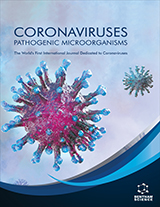Abstract
Severe acute respiratory syndrome coronavirus-2 (SARS-CoV-2), a single-stranded and positive- sense RNA virus, is exhibiting a great degree of mutation acclimated to variable environments, posing a great threat to human life, with numerous SARS-CoV-2 variants. This review aims to analyze emerging strains of SARS-CoV-2, their mutational pattern, their impact on viral pathogenicity, and the identification of the targets for the development of vaccines and therapeutics against the virus. SARSCoV- 2 consists of four structural protein codes viz, peplomer protein (S), an envelope protein (E), nucleoprotein capsid (N), and matrix protein (M), that are involved in the ingression of the viral genome into the host cell by interacting with the host cell receptor, i.e., human angiotensin-converting enzyme 2 (ACE2) (only S protein is shown to bind to ACE-2 receptor). The review includes consequences of mutations- D614G (pre-dominant mutation), E484K, N501Y, K417N, L452R, P681H, del69/70, del157/158, Ins214EPE, and so forth, in alpha, beta, gamma, delta, omicron including other strains of SARS-CoV-2. Mutations include substitution, deletion, and insertion of amino acids in the spike glycoprotein of the SARS-CoV-2, resulting in antibody neutralization, immune escape, etc. As a consequence of modifications in the nucleotide sequence of the viral genome code pushed on by exposure to various environments, these new strains influence the pathogenicity of the virus.
Keywords: SARS-CoV-2 spike mutations, D614G, N501Y, E484K, amino-acid substitution, RBD-hACE2 interactions.
[http://dx.doi.org/10.2174/2666796701666210105114804]
[http://dx.doi.org/10.1016/j.jiph.2020.12.009] [PMID: 33493917]
[http://dx.doi.org/10.1016/j.dsx.2020.04.020] [PMID: 32335367]
[http://dx.doi.org/10.3389/fmolb.2021.653148] [PMID: 34041264]
[http://dx.doi.org/10.1016/j.jpha.2020.03.009]
[http://dx.doi.org/10.1021/acs.jpcb.0c04511] [PMID: 32790406]
[http://dx.doi.org/10.1074/jbc.RA120.015303] [PMID: 33122196]
[http://dx.doi.org/10.1038/s41586-020-2180-5] [PMID: 32225176]
[http://dx.doi.org/10.1038/s41580-021-00418-x] [PMID: 34611326]
[http://dx.doi.org/10.1016/j.isci.2020.101212] [PMID: 32512386]
[http://dx.doi.org/10.2174/1570180817999201209204153]
[http://dx.doi.org/10.1016/j.jmb.2020.07.009] [PMID: 32710986]
[http://dx.doi.org/10.1016/j.bbrc.2020.10.109] [PMID: 33199022]
[http://dx.doi.org/10.3389/fmed.2022.815389] [PMID: 35273977]
[http://dx.doi.org/10.1016/j.cell.2020.06.043] [PMID: 32697968]
[http://dx.doi.org/10.1016/S2213-2600(21)00005-9] [PMID: 33417829]
[http://dx.doi.org/10.1126/science.abg3055] [PMID: 33658326]
[http://dx.doi.org/10.7554/eLife.61312] [PMID: 33112236]
[http://dx.doi.org/10.1038/s41586-021-03402-9] [PMID: 33690265]
[http://dx.doi.org/10.1016/j.jinf.2021.01.025] [PMID: 33548358]
[http://dx.doi.org/10.1038/s41586-021-03777-9] [PMID: 34237773]
[http://dx.doi.org/10.1126/science.abi7994] [PMID: 34210893]
[http://dx.doi.org/10.1038/s41467-021-25168-4] [PMID: 34373458]
[http://dx.doi.org/10.1080/14760584.2021.1976153] [PMID: 34488546]
[http://dx.doi.org/10.1016/j.addr.2021.01.014] [PMID: 33482248]
[http://dx.doi.org/10.1016/j.bjid.2021.101606] [PMID: 34428473]
[http://dx.doi.org/10.3389/fcimb.2021.781429] [PMID: 35118007]
[http://dx.doi.org/10.1016/j.isci.2021.103589] [PMID: 34909610]
[http://dx.doi.org/10.1038/s41586-020-2895-3] [PMID: 33106671]
[http://dx.doi.org/10.1073/pnas.2022586118] [PMID: 33579792]
[http://dx.doi.org/10.1038/s41594-021-00652-z] [PMID: 34385690]
[http://dx.doi.org/10.15585/mmwr.mm7003e2] [PMID: 33476315]
[http://dx.doi.org/10.1016/j.ijid.2021.03.005] [PMID: 33684558]
[http://dx.doi.org/10.1016/S1473-3099(21)00262-0] [PMID: 34022142]
[http://dx.doi.org/10.1038/s41579-021-00573-0] [PMID: 34075212]
[http://dx.doi.org/10.3201/eid2712.211792] [PMID: 34499599]
[http://dx.doi.org/10.1016/j.intimp.2021.108424] [PMID: 34915409]
[http://dx.doi.org/10.1038/s41586-021-03398-2] [PMID: 33684923]
[http://dx.doi.org/10.1016/j.jve.2021.100054] [PMID: 34548928]
[http://dx.doi.org/10.7554/eLife.70658] [PMID: 34435953]
[http://dx.doi.org/10.1073/pnas.2106480118] [PMID: 34588290]
[http://dx.doi.org/10.1016/j.meegid.2021.105192] [PMID: 34933126]
[http://dx.doi.org/10.1093/infdis/jiab368] [PMID: 34260717]
[http://dx.doi.org/10.3390/clinpract11040093] [PMID: 34698149]
[http://dx.doi.org/10.1038/s41586-021-03944-y] [PMID: 34488225]
[http://dx.doi.org/10.3390/microorganisms9071542] [PMID: 34361977]
[http://dx.doi.org/10.3389/fimmu.2021.701501] [PMID: 34322129]
[http://dx.doi.org/10.1007/s00705-022-05365-2] [PMID: 35089389]
[http://dx.doi.org/10.1016/j.jiph.2021.11.011] [PMID: 34856435]
[http://dx.doi.org/10.1128/mBio.01386-21] [PMID: 34311587]
[http://dx.doi.org/10.3389/fmedt.2021.694347] [PMID: 35047936]
[http://dx.doi.org/10.1017/ice.2021.390] [PMID: 34470685]
[http://dx.doi.org/10.1016/j.genrep.2021.101378] [PMID: 34632160]
[http://dx.doi.org/10.1016/j.celrep.2021.110237] [PMID: 34982967]
[http://dx.doi.org/10.1002/jmv.27491] [PMID: 34850421]
[http://dx.doi.org/10.1038/s41591-021-01678-y] [PMID: 35046573]
[http://dx.doi.org/10.26355/eurrev_202112_27653] [PMID: 34982466]
[http://dx.doi.org/10.1136/bmj.n359] [PMID: 33547053]
[http://dx.doi.org/10.1038/s41586-021-04266-9] [PMID: 34823256]
[http://dx.doi.org/10.1016/j.chom.2021.06.006] [PMID: 34171266]
[http://dx.doi.org/10.3389/fcell.2021.697035] [PMID: 34414185]
[http://dx.doi.org/10.1016/S2666-5247(21)00068-9] [PMID: 33846703]
[http://dx.doi.org/10.1002/jmv.27541] [PMID: 34936120]
[http://dx.doi.org/10.1016/j.cell.2021.01.037] [PMID: 33621484]






























